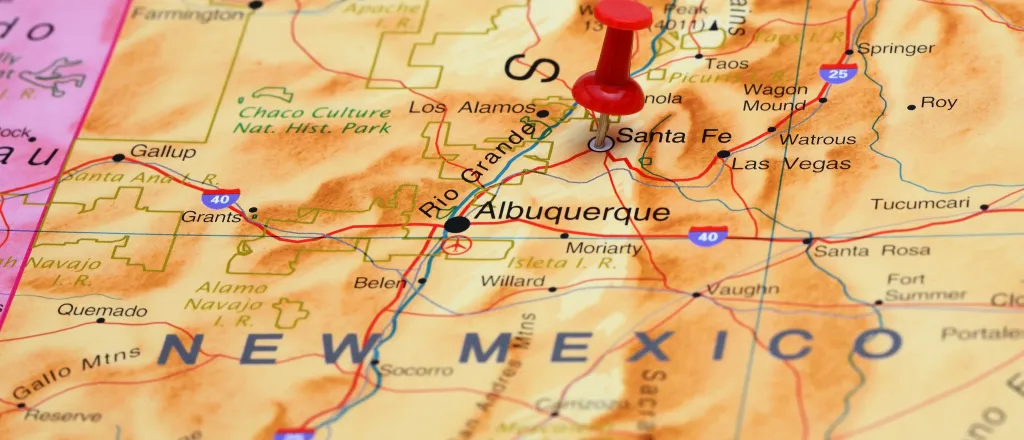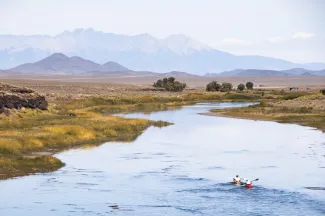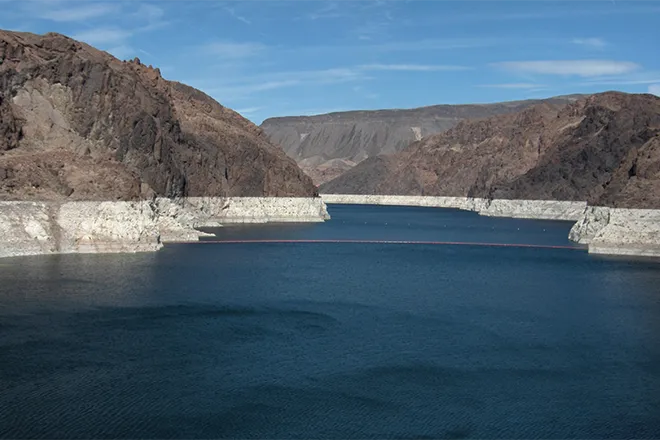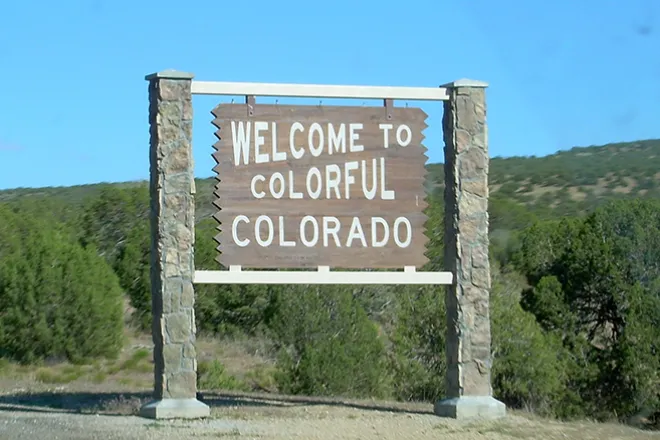
Ditch Democracy: Northern New Mexico’s Acequia Culture
One of the first things you notice when you enter Taos County, New Mexico is the water. Driving into the county from the south, you’ll follow the Rio Grande through its canyon, as it heads down towards Santa Fe and Albuquerque, carrying drinking water for the rest of the state and continuing on toward the Mexican border.
You might also notice that the land is crisscrossed by ditches. These ditches, called acequias, turn the high desert of the Taos Valley an improbable green. Acequias have been a cornerstone of agriculture and community in the Southwest since the arrival of Spanish settlers in the 17th century. These settlers drew inspiration from the irrigation systems of the Indigenous Pueblo communities already living and farming the Southwest, as well as from examples in their own Spanish and Moorish roots, resulting in the acequias that are still used today
Now, around 700 of these hand-built community-led irrigation ditches adorn the New Mexico high country, descending from the creeks that meander through the mountains into the high elevation valleys of northern New Mexico and beyond.
While acequia systems are concentrated heavily in northern New Mexico, they exist on every river system in the state, and extend up north to southern Colorado, especially in the San Luis Valley, an area more culturally similar to northern New Mexico than most of the rest of Colorado.
An Outsider’s Introduction to Acequias
On an early spring day in 1972, someone knocked on Hank Saxe’s door. Saxe was new to Taos County. He had just moved to the unincorporated town of Arroyo Seco, where he was taking care of an abandoned house that might otherwise have fallen into disrepair. Saxe’s surprise visitor turned out to be a neighbor with an invitation. “We’re cleaning the ditch in a few days, you’ve got to come,” he said.
That first annual spring cleaning, or limpia, was Saxe’s introduction to acequias. Today, Saxe and his wife, Cynthia Patterson, sit on the board for their acequia – Acequia Madre del Rio Chiquito – one of two acequias on the Rio Chiquito, a creek that comes out of Carson National Forest, flowing into the Taos valley and the Rio Grande watershed.
Hank Saxe tells stories while looking at a map of local acequias and property boundaries in his home in Ranchos de Taos, a community just south of Taos, New Mexico.
An Insider’s Cultural Knowledge
In contrast to Saxe, acequias are a way of life built into Carlos Arguello’s very lineage. There’s an acequia named after his great great grandfather in the Valdez valley, north of Taos, where Arguello grew up. His mother was a commissioner on an acequia in Valdez.
“It is part of the culture of growing up and that not only was I born into it and raised in it, I’ve been living it and it just becomes ingrained,” said Arguello, who is now a commissioner on his acequia, Acequia del Monte del Río Chiquito, the other acequia that comes off of the Rio Chiquito.
“Querencia— the love of land, the love of heritage, the love of place”
Carlos Arguello
The governance of each acequia includes a Mayordomo, or a ditch boss, who physically controls the water during the season. The Mayordomo has relationships with every parciante, or member, of the acequia and manages any issues that arise while water is flowing. The other two elected commissioners are a treasurer and a secretary. Each commissioner is elected by the parciantes.
“The governance of the acequias is the longest historical practice of democracy in the U.S.,” said Arguello.
Carlos Arguello opens and closes the headgate on the acequia on his property. When open, the water flows through to his fields to provide irrigation.
In the West, Water Is Political
Democratic principles are especially crucial for dry western states where water is inherently political. Without water, there is no life. Many western cities, like Phoenix and Las Vegas would not exist without water diversion technology. In rural communities, water diversion is vital for agriculture and economic growth, as well as simply for drinking.
In the West, there’s a water law principle known colloquially as “use it or lose it.” It’s part of the doctrine of prior appropriation, which forms the backbone of water law in the region. Within the doctrine, water rights are first come first served – whoever claims the water first, gets it first.

© joshschutz - iStock-133883324
Prior appropriation creates a pecking order too. The most senior water right holders get water first, based on their date of priority – the date the water was put into “beneficial use,” with more junior water right holders sometimes getting less water than promised in drought years – of which there are many in the Southwest.
The “lose it” part comes in if someone isn’t making “beneficial use” of the water. In New Mexico, if water isn’t used for four consecutive years, water rights can be forfeited. These complexities are the subject of many lawsuits and litigation can drag on for decades. The Abeyta settlement, a case that determined water rights for the Taos Valley, lasted more than 30 years.
Carlos Arguello’s truck sits in his driveway with a Taos Valley Acequia Association bumper sticker and a specialty license plate that benefits the Acequia Community Ditch Fund that pays for water rights advocacy and other service to protect water in the state.
Acequias, and their governance, were community-led long before modern Western water law was created. The acequia board and its members determined where water needed to go based on what each piece of land needed and how much water there was at any given time.
In 1907 things changed with the enactment of New Mexico’s water code.Now, the acequia system needed to be brought under New Mexico territorial law (New Mexico didn’t become a state until 1912), which followed the doctrine of prior appropriations and was set up for each water right to be held by an individual, not a collective.
The 1907 Acequia Act, included in New Mexico’s freshly-minted water code, made each acequia a political subdivision of the state of New Mexico, intending to standardize the management of these water systems, and making each water right the property of an individual instead of the acequia. This directly contradicted the historical, community-led acequia commission approach that prioritized the unique needs of each parciantes.
Because of the fear of “use it or lose it,” individuals are less likely to think about the system as a whole when they are worried about their own personal ability to use water. It’s one of the biggest issues with Western water generally. Even during a drought, farmers will use every drop of water they are legally entitled to, even if they don’t need it. The fear is that if they don’t, it will be taken away.

© Chris Sorensen
Talpa Reservoir is one of the only reservoirs fed by an acequia in northern New Mexico. The water for this reservoir comes form the Rio Chiquito and it holds around 330,000 gallons of water. Water is held in the reservoir for later in the season when the river starts to dry up.
Since the original water code was instituted, legislative efforts have worked to take back community control over each acequia. Acequias are again able to own their own water rights, and manage the transfer of water between parciantes as the Mayordomo sees fit.
Because of both the doctrine of prior appropriation, which incentivizes the consistent use of water, and the deep cultural connection to water and land, northern New Mexicans are incredibly protective of their water rights.
“We don’t want to lose any water. We don’t want water going down the Red River and down south. We are barely getting enough, but we get the water that we get. So we want to keep it in community as much as we can,” said Maria Gonzalez.
Gonzalez, who is the LOR Foundation program officer for Questa, New Mexico, owns land in Taos County that she and her husband irrigate.
She has been learning “the art of irrigation,” over the past few years, although her family also irrigated a bit when she was growing up. It’s an intensive process that involves flood-irrigating fields via ditches that branch off of the main acequia. Every few hours, someone has to open and close gates to move the flowing water and then move the tarps to catch the runoff.
One day, Gonzalez’ husband asked her to move the water in the middle of her work day, so she went out in the field in office attire and irrigation boots. There she sat, in the middle of the field on a camp chair, taking Zoom meetings while she irrigated.
“We are trying to teach the younger generation that when we irrigate, that goes back into our water reservoir and it keeps water, drinking water for us. So we need to have those irrigations,” she said.
Carlos Arguello points out an irrigated field with hundred year old apple trees as he drives us around the neighborhood to look at the acequia.
A Trip to the Source
On an early spring day, not unlike the day a neighbor first knocked on Hank Saxe’s door in 1972, Carlos Arguello took us out to visit the Rio Chiquito where it splits into its two acequias. We drove down dirt roads until they ended in a driveway. Arguello called the homeowner to let her know that we’d be checking out the acequia and walking across her property for a bit.
Acequias all have an easement on private property, which allows anyone working on an acequia, including commissioners, to legally access it via private property at any time. However, the commissioners still spend a lot of time getting to know landowners and building relationships in order to maintain cordiality around using private property.
At the mouth of the acequia, water streams out into two chutes. The slightly larger one, on the left, is the Acequia Madre del Rio Chiquito. On the right, the water flows into the Acequia del Monte del Río Chiquito.
Arguello spotted a branch caught in the junction between the two waterways, and we watched him pry open a hatch on the grate covering the splitting creek. He lowered his body into the streaming water, fishing the branch out, standing ankle deep in the water.
Carlos Arguello cleans a branch out of the acequia junction. He is standing in the smaller side, in the Acequia del Monte del Río Chiquito. The community acequia cleaning day happened only weeks before, but keeping the ditch clear of debris is a never-ending task.
Arguello said that issues can arise when newcomers move into a property that has an acequia on it. Not everyone is as open to understanding this community-driven water system as Saxe was when he moved to the area in the 70s.
Historically speaking, Arguello feels he’s not that much different than someone like Saxe. Arguello’s father’s family arrived in Santa Fe in 1695. “I’m a newcomer too. I mean, I’ve just been here longer, but I’m still a newcomer. I’m not Indigenous, although I’ve got Indigenous blood in me,” said Arguello.
Carlos Arguello cleans a tire out of the Acequia del Madre del Rio Chiquito.
He sees how his ancestors’ influence changed the community over generations, as well as how newcomers today might not understand the area’s unique history and culture.
“Land softly,” Arguello recommends to newcomers. “Then look around you. ‘What kind of a neighborhood am I in? What’s this about? What’s this water thing?’ Get to know your neighbors, get to understand them. They’re different from you. They’re different from where you came. That’s part of the reason you came here. Don’t expect them to assimilate to you.”
Hank Saxe points out his property on a map that shows all the property divisions in the neighborhood. Properties are divided into strips, with acequias and venitas –smaller ditches off of the main acequia— sometimes making up the borders.
Whether their existence is a surprise or deeply ingrained, acequias are the way of life for most people in Taos County.
“It’s part of what we call around here: querencia, the love of land, the love of heritage, the love of place,” said Arguello.
The post Ditch Democracy: Northern New Mexico’s Acequia Culture appeared first on The Daily Yonder.
















